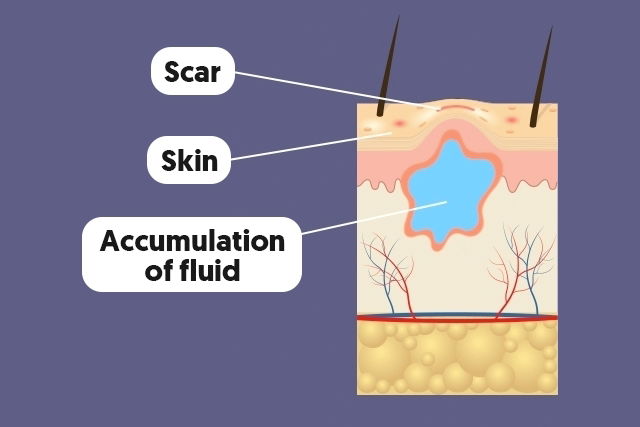A seroma is an accumulation of fluid below the skin which can occur anywhere in the body. It is a common complication that can occur after any surgery, and usually develops close to the surgical scar. This built-up fluid is more common after surgeries in which the skin and fat tissue have been cut and manipulated, which can happen in plastic surgery, abdominoplasty, liposuction, breast surgeries or after a c-section delivery.
A small seroma is usually reabsorbed naturally into the body within 10 to 21 days. However, in some cases, the doctor may need to carry out a small procedure which consists of inserting a syringe under the skin and removing the excess fluid.
To reduce the risk of having a seroma, the doctor will typically recommended the use compression bandages after surgery. It is important to note that seroma usually develop as a result of local inflammation, and not due to the procedure itself.

Main symptoms
A seroma can be identified by the presence of the following signs and symptoms:
- Transparent or clear fluid under the wound
- Local swelling
- Unevenness in the area
- Pain in or around the wound
- Redness and increased temperature in the area surrounding the wound
There may be a reddish or brown coloring underneath the skin when the seroma is mixed with blood. This is more common soon after surgery and tends to become clearer as the healing process continues.
A seroma usually appears within the first 2 weeks of surgery as a result of the built-up of fluid in the dead space between the layers of the skin. If you see or feel symptoms that may indicate a seroma, follow-up with the surgeon for assessment and to evaluate whether treatment is needed.
Common causes
Seromas can appear after any type of surgery, depending on how a person’s body recovers. However, this type of complication is more common in:
- Extensive surgeries such as a mastectomy following a cancer diagnosis
- Surgeries requiring the placement of drains post-operatively
- Surgeries that cause lesions in various types of tissues
- People who have a previous history of seromas
Although it is a very common complication, seromas can be easily avoided by using a bandage over the scar and by avoiding any intense exercise unless approved by the doctor.
If there is an increased risk of developing a seroma, the doctor usually inserts a drain during surgery so that the built-up fluid may leak out as the wound heals.
Treatment options
Treatment for a seroma is only necessary when there is a significant accumulation of fluid, or if the seroma is causing pain. Less severe cases of seromas will usually be reabsorbed in the body over time. However, when necessary, the fluid is removed using a syringe, or with a drain, which is a small tube inserted underneath the skin that allows fluid to clear out.
For pain relief, your surgeon may prescribe analgesics or anti-inflammatory drugs like acetaminophen or ibuprofen.
Treatment for an encapsulated seroma is more complicated, and requires injected corticosteroids or surgery. Ultrasonic cavitation is another a method that may be recommended. This involves the use of high-power ultrasound waves to stimulate the seroma and promote fluid removal.
If the seroma becomes infected, treatment with prescription antibiotics is indicated. For an encapsulated seroma, the doctor may recommend surgery to remove the fluid and to improve the aesthetic of the scar.
Learn more specifically about c-section recovery, including typical duration and wound care.






























